by的用法小结
by的用法小结
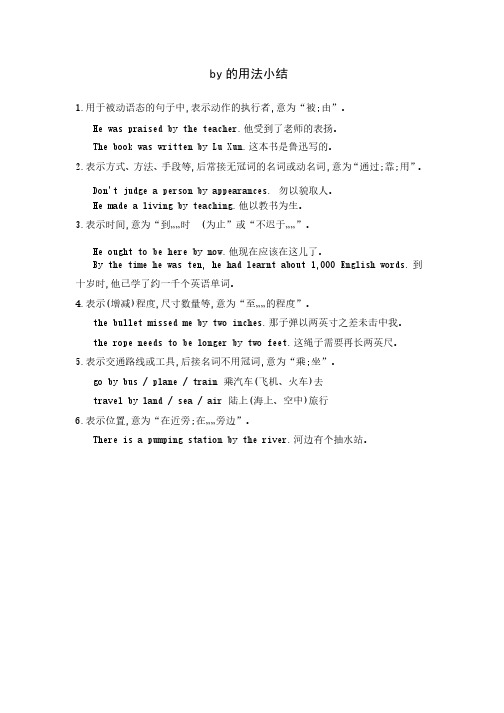
by 的用法小结1.1.用于被动语态的句子中用于被动语态的句子中用于被动语态的句子中,,表示动作的执行者表示动作的执行者,,意为“被意为“被;;由”。
由”。
He was praised by the teacher.He was praised by the teacher.他受到了老师的表扬。
他受到了老师的表扬。
他受到了老师的表扬。
The book was written by Lu Xun.The book was written by Lu Xun.这本书是鲁迅写的。
这本书是鲁迅写的。
这本书是鲁迅写的。
2.2.表示方式、表示方式、方法、手段等手段等,,后常接无冠词的名词或动名词后常接无冠词的名词或动名词,,意为“通过“通过;;靠;用”。
Don't judge a person by appearances. 勿以貌取人。
勿以貌取人。
He made a living by teaching.He made a living by teaching.他以教书为生。
他以教书为生。
他以教书为生。
3.3.表示时间表示时间表示时间,,意为“到……时(为止”或“不迟于……”。
He ought to be here by now.He ought to be here by now.他现在应该在这儿了。
他现在应该在这儿了。
他现在应该在这儿了。
By the time he was ten, he had learnt about 1,000 English words.到十岁时十岁时,,他已学了约一千个英语单词。
他已学了约一千个英语单词。
4.4.表示表示表示((增减增减))程度程度,,尺寸数量等尺寸数量等,,意为“至……的程度”。
the bullet missed me by two inches.那子弹以两英寸之差未击中我。
那子弹以两英寸之差未击中我。
the rope needs to be longer by two feet.这绳子需要再长两英尺。
介词by的用法归纳及例句
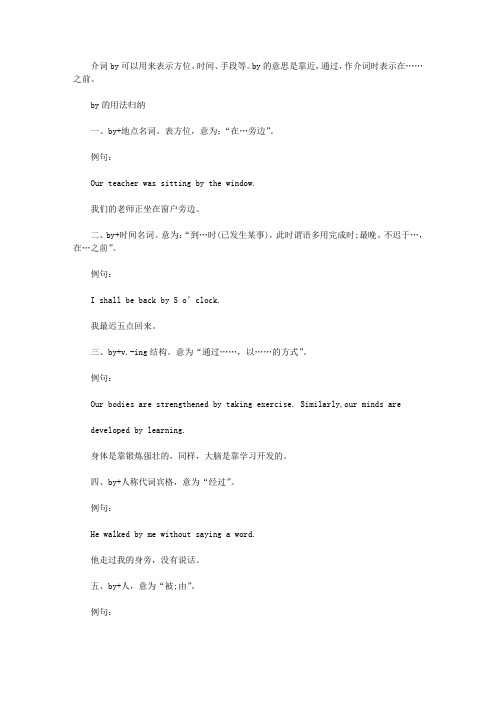
介词by可以用来表示方位、时间、手段等。
by的意思是靠近,通过,作介词时表示在……之前。
by的用法归纳一、by+地点名词。
表方位,意为:“在…旁边”。
例句:Our teacher was sitting by the window.我们的老师正坐在窗户旁边。
二、by+时间名词。
意为:“到…时(已发生某事),此时谓语多用完成时;最晚、不迟于…,在…之前”。
例句:I shall be back by 5 o’clock.我最迟五点回来。
三、by+v.-ing结构。
意为“通过……,以……的方式”。
例句:Our bodies are strengthened by taking exercise. Similarly,our minds aredeveloped by learning.身体是靠锻炼强壮的,同样,大脑是靠学习开发的。
四、by+人称代词宾格,意为“经过”。
例句:He walked by me without saying a word.他走过我的身旁,没有说话。
五、by+人,意为“被;由”。
例句:The movie is loved by people all over Asia.那个电影被全亚洲人喜爱。
六、by+地点或工具等具体名词。
表路线、途径,意为:“通过(某物、某地),取道…”。
例句:The man entered the room by the back door.那人通过后门进入了房间。
七、by的常用短语Study by heart 用心学little by little 渐渐地one by one 逐一by chance 碰巧,偶然by the river 在河边by mistake 错误地by nature 天生的by oneself 亲自。
by的用法总结 例句
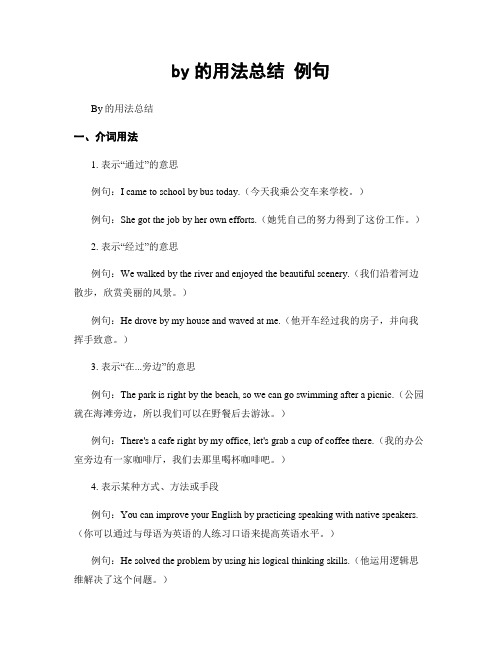
by的用法总结例句By的用法总结一、介词用法1. 表示“通过”的意思例句:I came to school by bus today.(今天我乘公交车来学校。
)例句:She got the job by her own efforts.(她凭自己的努力得到了这份工作。
)2. 表示“经过”的意思例句:We walked by the river and enjoyed the beautiful scenery.(我们沿着河边散步,欣赏美丽的风景。
)例句:He drove by my house and waved at me.(他开车经过我的房子,并向我挥手致意。
)3. 表示“在...旁边”的意思例句:The park is right by the beach, so we can go swimming after a picnic.(公园就在海滩旁边,所以我们可以在野餐后去游泳。
)例句:There's a cafe right by my office, let's grab a cup of coffee there.(我的办公室旁边有一家咖啡厅,我们去那里喝杯咖啡吧。
)4. 表示某种方式、方法或手段例句:You can improve your English by practicing speaking with native speakers.(你可以通过与母语为英语的人练习口语来提高英语水平。
)例句:He solved the problem by using his logical thinking skills.(他运用逻辑思维解决了这个问题。
)五、表示“根据”的意思例句:By the look on her face, I knew something was wrong.(通过她脸上的表情,我知道有些事情出了问题。
)例句:By my calculation, we should reach our destination in a few hours.(根据我的计算,我们应该在几个小时内到达目的地。
by的所有用法
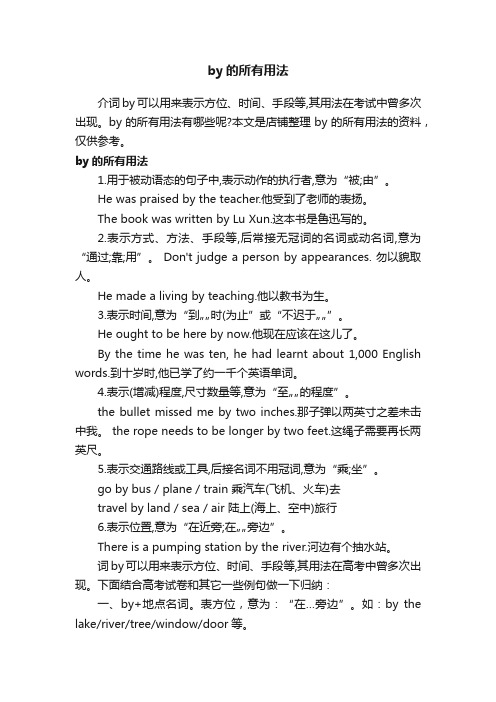
by的所有用法介词by可以用来表示方位、时间、手段等,其用法在考试中曾多次出现。
by的所有用法有哪些呢?本文是店铺整理by的所有用法的资料,仅供参考。
by的所有用法1.用于被动语态的句子中,表示动作的执行者,意为“被;由”。
He was praised by the teacher.他受到了老师的表扬。
The book was written by Lu Xun.这本书是鲁迅写的。
2.表示方式、方法、手段等,后常接无冠词的名词或动名词,意为“通过;靠;用”。
Don't judge a person by appearances. 勿以貌取人。
He made a living by teaching.他以教书为生。
3.表示时间,意为“到……时(为止”或“不迟于……”。
He ought to be here by now.他现在应该在这儿了。
By the time he was ten, he had learnt about 1,000 English words.到十岁时,他已学了约一千个英语单词。
4.表示(增减)程度,尺寸数量等,意为“至……的程度”。
the bullet missed me by two inches.那子弹以两英寸之差未击中我。
the rope needs to be longer by two feet.这绳子需要再长两英尺。
5.表示交通路线或工具,后接名词不用冠词,意为“乘;坐”。
go by bus / plane / train 乘汽车(飞机、火车)去travel by land / sea / air 陆上(海上、空中)旅行6.表示位置,意为“在近旁;在……旁边”。
There is a pumping station by the river.河边有个抽水站。
词by可以用来表示方位、时间、手段等,其用法在高考中曾多次出现。
下面结合高考试卷和其它一些例句做一下归纳:一、by+地点名词。
介词by的用法总结归纳

介词by的用法总结归纳一、by的基本用法总结在英语中,介词by是一个非常常用的介词,它有着多种不同的用法和含义。
在这篇文章中,我们将对by的用法进行总结和归纳。
1. 表示手段或方法by可以表示通过某种手段或方法来完成某事。
例如:- She travels to work by bus every day.- I learned to play the piano by practicing every day.2. 表示传达方式by可以表示信息是通过什么方式传达给他人的。
例如:- I received the news by email.- The message was delivered by a messenger.3. 表示交通工具by可用于描述旅行或移动时所使用的交通工具。
例如:- They went to Paris by train.- We will travel to the island by boat.4. 表示位置或方向by可以用来指示一个物体相对于另一个物体的位置或方向。
例如:- He sat by the window.- The cat is hiding under the table, by my feet.5. 表示陪伴或靠近关系by可以表示陪伴或靠近关系。
例如:- She always stands by her friends.- My dog is always by my side.6. 表示时间点by可用于表示某个特定时间点之前或之后。
例如:- I will finish my work by 6 o'clock.- The report needs to be submitted by Friday.7. 表示被动行为的执行者by可以指示一个动作的执行者是谁。
这在被动语态中经常使用。
例如:- The book was written by J.K. Rowling.- The painting was created by Picasso.二、by短语用法总结除了基本用法外,by还会构成一些常用的短语,这些短语具有特定的含义和用法。
by的几个用法
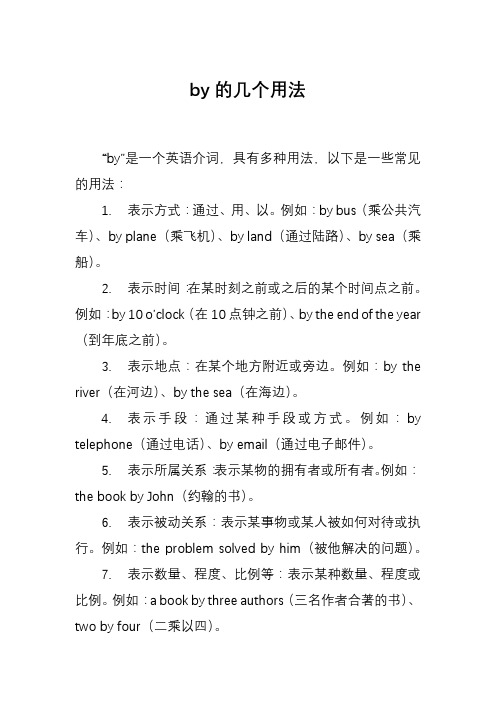
by的几个用法
“by”是一个英语介词,具有多种用法,以下是一些常见的用法:
1. 表示方式:通过、用、以。
例如:by bus(乘公共汽车)、by plane(乘飞机)、by land(通过陆路)、by sea(乘船)。
2. 表示时间:在某时刻之前或之后的某个时间点之前。
例如:by 10 o’clock(在10点钟之前)、by the end of the year (到年底之前)。
3. 表示地点:在某个地方附近或旁边。
例如:by the river(在河边)、by the sea(在海边)。
4. 表示手段:通过某种手段或方式。
例如:by telephone(通过电话)、by email(通过电子邮件)。
5. 表示所属关系:表示某物的拥有者或所有者。
例如:the book by John(约翰的书)。
6. 表示被动关系:表示某事物或某人被如何对待或执行。
例如:the problem solved by him(被他解决的问题)。
7. 表示数量、程度、比例等:表示某种数量、程度或比例。
例如:a book by three authors(三名作者合著的书)、two by four(二乘以四)。
以上是“by”的一些常见用法,希望能对您有所帮助。
by的用法总结归纳

by的用法总结归纳一、概述在英语中,"by" 是一个常见的介词,具有多种用法和意义。
本文将对 "by" 的用法进行总结和归纳,帮助读者更好地掌握和运用该介词。
二、表示方式或方法1. 表示通过某种方式实现目标:例如:I learned English by watching movies.(我通过观看电影学习英语。
)2. 表示凭借手段或工具完成某事:例如:He fixed the computer by using a screwdriver.(他使用螺丝刀修理了电脑。
)3. 表示依靠某个特定的人或物体进行行动:例如:She travels by train to work every day.(她每天乘坐火车上班。
)三、表示时间、频率或限制1. 表示经过了多少时间:例如:I will finish this report by tomorrow.(我将在明天之前完成这份报告。
)2. 表示截止日期或最大限度:例如:You must submit your application by Friday.(你必须在星期五之前提交申请。
)3. 表示按照一定的时间周期或频率:例如:We have a meeting every Monday from 9 am to 10 am, and also on Wednesday at the same time, by appointment only.(我们每周一上午9点到10点有会议,并且每周三同样的时间,只按预约安排。
)四、表示位置或方向1. 表示位于某个地方或途径:例如:The hotel is right by the beach.(这家酒店就在海边。
)2. 表示通过、经过某个地方:例如:We walked by the park on our way home.(我们在回家的路上经过了公园。
)五、表示原因或动机1. 表示由于某种原因进行行动:例如:He left early by fear of missing the train.(他为了怕错过火车而提前离开。
(完整版)by的用法总结
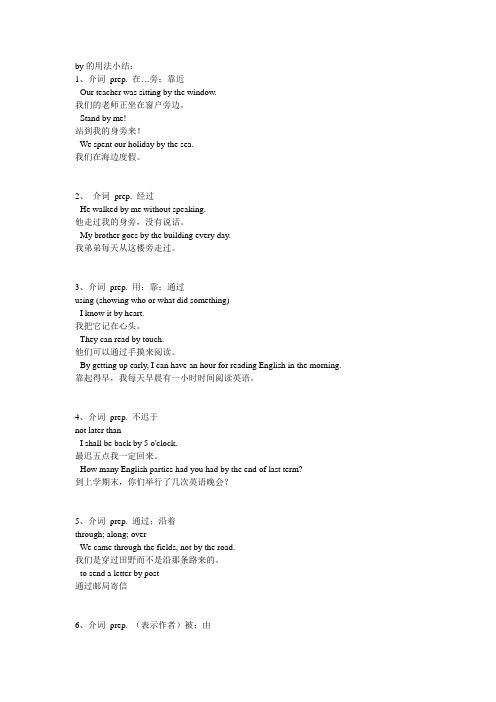
by的用法小结:1、介词prep. 在…旁;靠近· Our teacher was sitting by the window.我们的老师正坐在窗户旁边。
· Stand by me!站到我的身旁来!· We spent our holiday by the sea.我们在海边度假。
2、介词prep. 经过· He walked by me without speaking.他走过我的身旁,没有说话。
· My brother goes by the building every day.我弟弟每天从这楼旁走过。
3、介词prep. 用;靠;通过using (showing who or what did something)· I know it by heart.我把它记在心头。
· They can read by touch.他们可以通过手摸来阅读。
· By getting up early, I can have an hour for reading English in the morning. 靠起得早,我每天早晨有一小时时间阅读英语。
4、介词prep. 不迟于not later than· I shall be back by 5 o'clock.最迟五点我一定回来。
· How many English parties had you had by the end of last term?到上学期末,你们举行了几次英语晚会?5、介词prep. 通过;沿着through; along; over· We came through the fields, not by the road.我们是穿过田野而不是沿那条路来的。
· to send a letter by post通过邮局寄信6、介词prep. (表示作者)被;由word that shows the author, painter, etc.· Thirty divided by two is fifteen.三十除以二得十五。
by的用法归纳总结
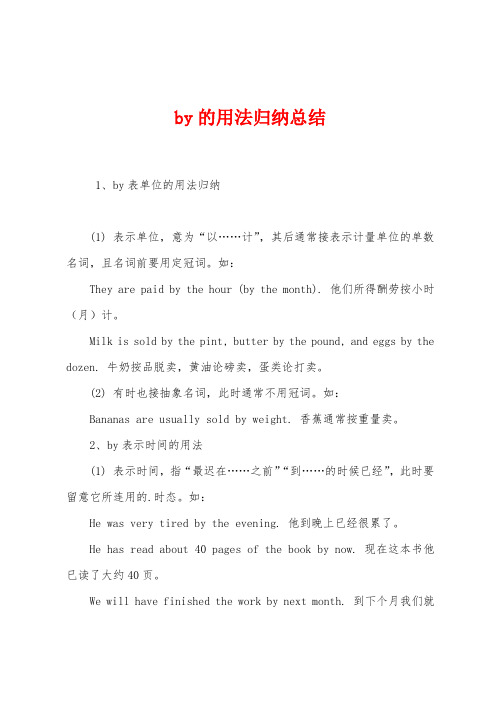
by的用法归纳总结1、by表单位的用法归纳(1) 表示单位,意为“以……计”,其后通常接表示计量单位的单数名词,且名词前要用定冠词。
如:They are paid by the hour (by the month). 他们所得酬劳按小时(月)计。
Milk is sold by the pint, butter by the pound, and eggs by the dozen. 牛奶按品脱卖,黄油论磅卖,蛋类论打卖。
(2) 有时也接抽象名词,此时通常不用冠词。
如:Bananas are usually sold by weight. 香蕉通常按重量卖。
2、by表示时间的用法(1) 表示时间,指“最迟在……之前”“到……的时候已经”,此时要留意它所连用的.时态。
如:He was very tired by the evening. 他到晚上已经很累了。
He has read about 40 pages of the book by now. 现在这本书他已读了大约40页。
We will have finished the work by next month. 到下个月我们就会干完了这工作。
By the time the doctor arrived the patient had died. 在医生到达时,病人已经死了。
(2) 另外,表示时间时,它还可表示“在……期间”,通常连用的名词是 day, night, moonlight, daylight等,留意名词前通常不用冠词。
如:Cats sleep by day and hunt by night. 猫白天睡觉,夜里捉老鼠。
Do you like to swim by moonlight? 你喜爱在月光下游泳吗?3、表示手段或方式等,留意以下用法:(1) 表示“乘”“坐”时,其后接交通工具(如 bus, bike, train, plane, car, taxi, ship等)或与交通工具亲密相关的名词(如air, water, land, road等),在句中主要用作方式状语,其中通常不用冠词或其他限定词。
by的用法总结
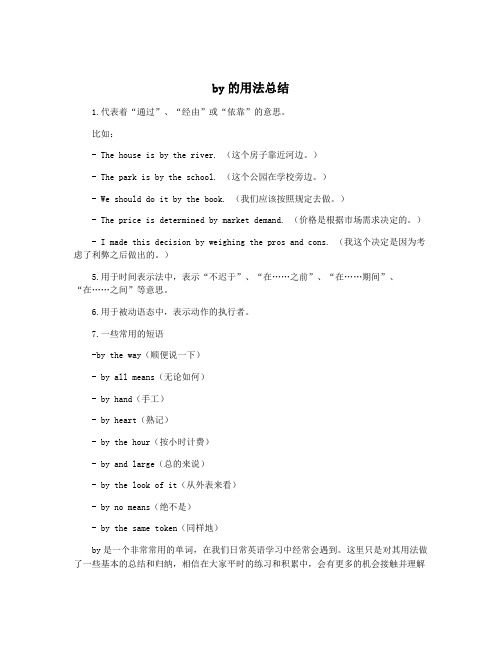
by的用法总结1.代表着“通过”、“经由”或“依靠”的意思。
比如:- The house is by the river. (这个房子靠近河边。
)- The park is by the school. (这个公园在学校旁边。
)- We should do it by the book. (我们应该按照规定去做。
)- The price is determined by market demand. (价格是根据市场需求决定的。
)- I made this decision by weighing the pros and cons. (我这个决定是因为考虑了利弊之后做出的。
)5.用于时间表示法中,表示“不迟于”、“在……之前”、“在……期间”、“在……之间”等意思。
6.用于被动语态中,表示动作的执行者。
7.一些常用的短语-by the way(顺便说一下)- by all means(无论如何)- by hand(手工)- by heart(熟记)- by the hour(按小时计费)- by and large(总的来说)- by the look of it(从外表来看)- by no means(绝不是)- by the same token(同样地)by是一个非常常用的单词,在我们日常英语学习中经常会遇到。
这里只是对其用法做了一些基本的总结和归纳,相信在大家平时的练习和积累中,会有更多的机会接触并理解它的含义和用法。
除了以上提到的基本用法,by还有许多其他的用法和含义,下面我们来介绍一些常见的。
8.表示身份或成为代表在这种情况下,by用于表示身份或成为代表的含义。
比如:- She works for the company by day, but is a singer by night. (她白天在公司工作,晚上是一名歌手。
)- He represented his school by participating in the debate competition. (他代表他的学校参加辩论比赛。
介词 by 的用法归纳
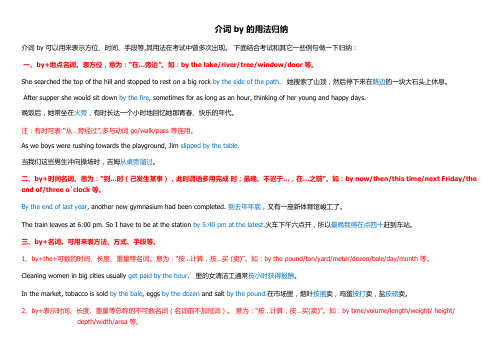
介词 by 的用法归纳介词 by 可以用来表示方位、时间、手段等,其用法在考试中曾多次出现。
下面结合考试和其它一些例句做一下归纳:一、by+地点名词。
表方位,意为:“在…旁边”。
如:by the lake/river/tree/window/door 等。
She searched the top of the hill and stopped to rest on a big rock by the side of the path.她搜索了山顶,然后停下来在路边的一块大石头上休息。
After supper she would sit down by the fire, sometimes for as long as an hour, thinking of her young and happy days.晚饭后,她常坐在火旁,有时长达一个小时地回忆她那青春、快乐的年代。
注:有时可表:“从…旁经过”,多与动词 go/walk/pass 等连用。
As we boys were rushing towards the playground, Jim slipped by the table.当我们这些男生冲向操场时,吉姆从桌旁溜过。
二、by+时间名词。
意为:“到…时(已发生某事),此时谓语多用完成时;最晚、不迟于…,在…之前”。
如:by now/then/this time/next Friday/the end of/three o`clock 等。
By the end of last year, another new gymnasium had been completed. 到去年年底,又有一座新体育馆峻工了。
The train leaves at 6:00 pm. So I have to be at the station by 5:40 pm at the latest.火车下午六点开,所以最晚我得在点四十赶到车站。
By的用法小节
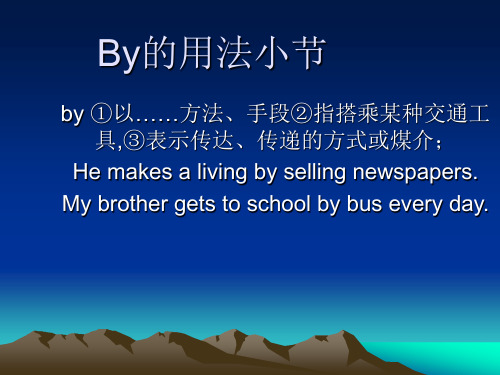
With 和 in 的用法
• with ①表示用 …工具(具体有形的工具) ②(表材料或内容)以,用……来填充
• He broke the window with a stone.
in 表示用…方式,用…语言(语调、笔墨、颜色)等; What's this in English?
用by, with, in填空
身边放着一个篮子。 • 16.He fell asleep______the lamp burning. 他没熄灯就睡着了。 • 17. He sat there ______ his eyes closed. 他闭目坐在那儿。
Hale Waihona Puke • 18.You must return _______ 10:00 pm.
By的用法小节
by ①以……方法、手段②指搭乘某种交通工 具,③表示传达、传递的方式或煤介;
新版by的用法总结

新版by的用法总结by的用法小结:ﻫ1、介词 prep。
在…旁;靠近·Our teacher was sitting by the window。
我们的老师正坐在窗户旁边。
· Stand by me!ﻫ站到我的身旁来!ﻫ· We spent ourholidaybythesea.2、介词我们在海边度假。
ﻫprep。
经过ﻫ· He walkedby me without speaking。
他走过我的身旁,没有说话。
ﻫ· My brother goes by thebuild ing every day.我弟弟每天从这楼旁走过。
3、介词prep。
用;靠;通过ﻫusing(showingwho or what did something)· I knowit by heart。
我把它记在心头。
·They can read by touch. ﻫ他们可以通过手摸来阅读。
ﻫ· By getting up early,I can have an hour for reading English in the morning. ﻫ靠起得早,我每天早晨有一小时时间阅读英语。
ﻫ4、介词 prep。
不迟于not later than ﻫ· I shall beback by 5 o'clock. 最迟五点我一定回来. ﻫ· How ma ny English parties had you hadby the end of last ter m? 到上学期末,你们举行了几次英语晚会?5、介词prep. 通过;沿着through;along;over · We came through the fields, not bythe road。
我们是穿过田野而不是沿那条路来的.· to sendaletter bypost通过邮局寄信6、介词 prep.(表示作者)被;由ﻫword that shows the author,painter,etc. ﻫ·Thirty divided by twois fifteen。
介词by的用法归纳
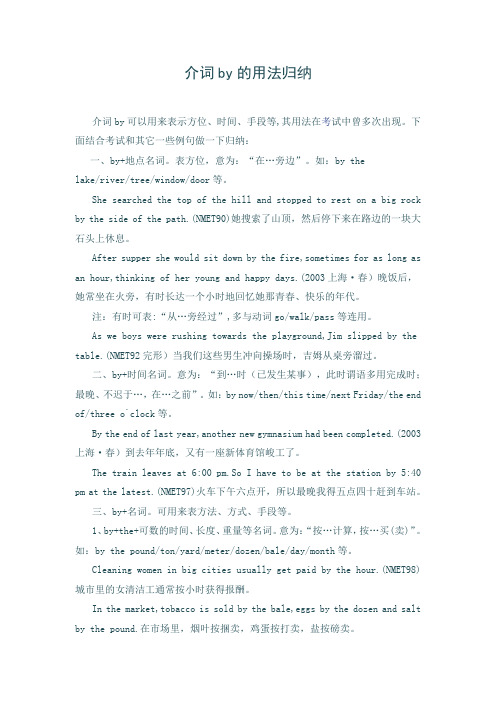
介词by的用法归纳介词by可以用来表示方位、时间、手段等,其用法在考试中曾多次出现。
下面结合考试和其它一些例句做一下归纳:一、by+地点名词。
表方位,意为:“在…旁边”。
如:by thelake/river/tree/window/door等。
She searched the top of the hill and stopped to rest on a big rock by the side of the path.(NMET90)她搜索了山顶,然后停下来在路边的一块大石头上休息。
After supper she would sit down by the fire,sometimes for as long as an hour,thinking of her young and happy days.(2003上海·春)晚饭后,她常坐在火旁,有时长达一个小时地回忆她那青春、快乐的年代。
注:有时可表:“从…旁经过”,多与动词go/walk/pass等连用。
As we boys were rushing towards the playground,Jim slipped by the table.(NMET92完形)当我们这些男生冲向操场时,吉姆从桌旁溜过。
二、by+时间名词。
意为:“到…时(已发生某事),此时谓语多用完成时;最晚、不迟于…,在…之前”。
如:by now/then/this time/next Friday/the end of/three o`clock等。
By the end of last year,another new gymnasium had been completed.(2003上海·春)到去年年底,又有一座新体育馆峻工了。
The train leaves at 6:00 pm.So I have to be at the station by 5:40 pm at the latest.(NMET97)火车下午六点开,所以最晚我得五点四十赶到车站。
by的用法小结

by的用法小结"by" 是一个多功能的英语介词,具有多种用法。
以下是"by" 的一些常见用法小结:1.表示方式、方法或手段:I go to work by car.(我开车去上班。
)She communicates by using sign language.(她通过手语交流。
)2.表示作者或制作者:This book was written by a famous author.(这本书是一位著名作者写的。
)The painting was created by a renowned artist.(这幅画是一位著名艺术家创作的。
)3.表示经过某个地点或位置:We drove by the park on our way home.(我们回家的路上经过了公园。
)The store is located by the river.(商店位于河边。
)4.表示在某个时间之前:I will finish the report by Friday.(我会在周五之前完成报告。
)Please submit your application by the deadline.(请在截止日期之前提交申请。
)5.表示通过某种手段或标准进行比较:She won the game by scoring the most points.(她通过得分最高赢得了比赛。
)You can measure the success of a project by its impact on the community.(你可以通过项目对社区的影响来衡量其成功与否。
)6.表示陪同:I'll be by your side no matter what happens.(无论发生什么,我都会在你身边。
)7.表示数量单位:The milk is sold by the liter.(牛奶按升出售。
by用法小结
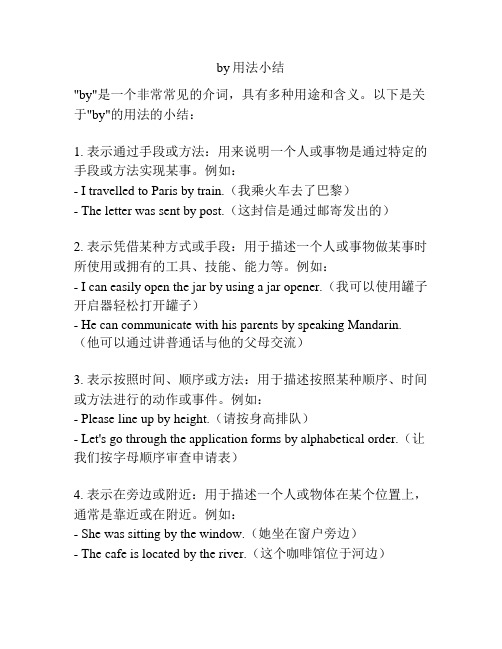
by用法小结"by"是一个非常常见的介词,具有多种用途和含义。
以下是关于"by"的用法的小结:1. 表示通过手段或方法:用来说明一个人或事物是通过特定的手段或方法实现某事。
例如:- I travelled to Paris by train.(我乘火车去了巴黎)- The letter was sent by post.(这封信是通过邮寄发出的)2. 表示凭借某种方式或手段:用于描述一个人或事物做某事时所使用或拥有的工具、技能、能力等。
例如:- I can easily open the jar by using a jar opener.(我可以使用罐子开启器轻松打开罐子)- He can communicate with his parents by speaking Mandarin.(他可以通过讲普通话与他的父母交流)3. 表示按照时间、顺序或方法:用于描述按照某种顺序、时间或方法进行的动作或事件。
例如:- Please line up by height.(请按身高排队)- Let's go through the application forms by alphabetical order.(让我们按字母顺序审查申请表)4. 表示在旁边或附近:用于描述一个人或物体在某个位置上,通常是靠近或在附近。
例如:- She was sitting by the window.(她坐在窗户旁边)- The cafe is located by the river.(这个咖啡馆位于河边)5. 表示处于某种状态:用于描述一个人或物体处于某种状态、情况或条件。
例如:- He was shocked by the news.(他对这个消息感到震惊)- I was distracted by the noise.(我被噪音分心了)6. 表示经过或经过某地:用于描述一个人或物体经过某个地点或从某个地点经过。
英语by的用法归纳
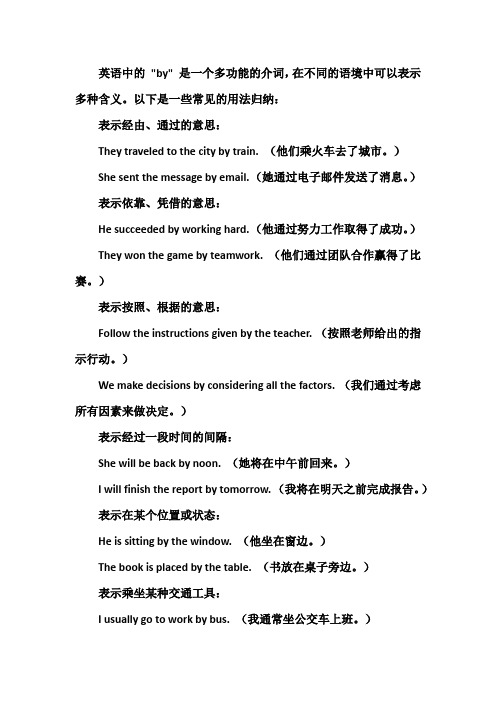
英语中的"by" 是一个多功能的介词,在不同的语境中可以表示多种含义。
以下是一些常见的用法归纳:表示经由、通过的意思:They traveled to the city by train. (他们乘火车去了城市。
)She sent the message by email. (她通过电子邮件发送了消息。
)表示依靠、凭借的意思:He succeeded by working hard. (他通过努力工作取得了成功。
)They won the game by teamwork. (他们通过团队合作赢得了比赛。
)表示按照、根据的意思:Follow the instructions given by the teacher. (按照老师给出的指示行动。
)We make decisions by considering all the factors. (我们通过考虑所有因素来做决定。
)表示经过一段时间的间隔:She will be back by noon. (她将在中午前回来。
)I will finish the report by tomorrow. (我将在明天之前完成报告。
)表示在某个位置或状态:He is sitting by the window. (他坐在窗边。
)The book is placed by the table. (书放在桌子旁边。
)表示乘坐某种交通工具:I usually go to work by bus. (我通常坐公交车上班。
)She traveled to Europe by plane. (她乘飞机去了欧洲。
)需要注意的是,"by" 还有其他一些特殊用法,具体语境可能会有所变化。
因此,在具体使用时,需要根据语境和语义选择正确的含义。
- 1、下载文档前请自行甄别文档内容的完整性,平台不提供额外的编辑、内容补充、找答案等附加服务。
- 2、"仅部分预览"的文档,不可在线预览部分如存在完整性等问题,可反馈申请退款(可完整预览的文档不适用该条件!)。
- 3、如文档侵犯您的权益,请联系客服反馈,我们会尽快为您处理(人工客服工作时间:9:00-18:30)。
by的用法小结1.用于被动语态的句子中,表示动作的执行者,意为“被;由”。
He was praised by the teacher.他受到了老师的表扬。
The book was written by Lu Xun.这本书是鲁迅写的。
2.表示方式、方法、手段等,后常接无冠词的名词或动名词,意为“通过;靠;用”。
Don't judge a person by appearances. 勿以貌取人。
He made a living by teaching.他以教书为生。
3.表示时间,意为“到……时(为止”或“不迟于……”。
He ought to be here by now.他现在应该在这儿了。
By the time he was ten, he had learnt about 1,000 English words.到十岁时,他已学了约一千个英语单词。
4.表示(增减)程度,尺寸数量等,意为“至……的程度”。
the bullet missed me by two inches.那子弹以两英寸之差未击中我。
the rope needs to be longer by two feet.这绳子需要再长两英尺。
5.表示交通路线或工具,后接名词不用冠词,意为“乘;坐”。
go by bus / plane / train 乘汽车(飞机、火车)去travel by land / sea / air 陆上(海上、空中)旅行6.表示位置,意为“在近旁;在……旁边”。
There is a pumping station by the river.河边有个抽水站。
词by可以用来表示方位、时间、手段等,其用法在高考中曾多次出现。
下面结合高考试卷和其它一些例句做一下归纳:一、by+地点名词。
表方位,意为:“在…旁边”。
如:by the lake/river/tree/window/door 等。
She searched the top of the hill and stopped to rest on a big rock by the side of the path.(NMET90)她搜索了山顶,然后停下来在路边的一块大石头上休息。
After supper she would sit down by the fire,sometimes for as long as an hour,thinking of her young and happy days.(2003上海·春)晚饭后,她常坐在火旁,有时长达一个小时地回忆她那青春、快乐的年代。
注:有时可表:“从…旁经过”,多与动词go/walk/pass等连用。
As we boys were rushing towards the playground,Jim slipped by the table.(NMET92完形)当我们这些男生冲向操场时,吉姆从桌旁溜过。
二、by+时间名词。
意为:“到…时(已发生某事),此时谓语多用完成时;最晚、不迟于…,在…之前”。
如:by now/then/this time/next Friday/the end of/three o`clock 等。
By the end of last year,another new gymnasium had been completed.(2003上海·春)到去年年底,又有一座新体育馆峻工了。
The train leaves at 6:00 pm.So I have to be at the station by 5:40 pm at the latest.(NMET97)火车下午六点开,所以最晚我得五点四十赶到车站。
三、by+名词。
可用来表方法、方式、手段等。
1、by+the+可数的时间、长度、重量等名词。
意为:“按…计算,按…买(卖)”。
如:by the pound/ton/yard/meter/dozen/bale/day/month等。
Cleaning women in big cities usually get paid by the hour.(NMET98)城市里的女清洁工通常按小时获得报酬。
In the market,tobacco is sold by the bale,eggs by the dozen and salt by the pound.在市场里,烟叶按捆卖,鸡蛋按打卖,盐按磅卖。
2、by+表示时间、长度、重量等总称的不可数名词(名词前不加冠词)。
意为:“按…计算,按…买(卖)”。
如:by time/volume/length/weight/height/depth/width/area等。
As we all know,the freight of the luggage is charged by weight.众所周知,行李的运费是按重量计算的。
3、by+交通工具、交通方式名词(名词前不加冠词,不变复数)。
意为:“通过…,由…,乘…”。
如by train/rail/tube/taxi/bus/truck/bike/boat/plane;by land/road/sea/water/air等。
(on foot)It takes a long time to go there by train;it`s quicker by road.(或by bus)(NMET93)乘火车去那儿要花很长时间,公路比较快。
“I usually go there by train”.“Why not try going by boat(或water)for a change?”(NMET92)“我常乘火车去那儿。
”“为何不尝试一下坐船呢?”4、by+抽象名词或具有抽象意义的普通名词(名词前不加冠词,不变复数)。
意为:“靠…,通过…,由…所致”。
如:by skill/determination/practice/diligence/inference/chance/accident;by mail/letter/radio/fax/telephone/telegraph/hand/machine等。
Although he had been searching in the wrong area most of the time,he found it by logic,not by luck.(NMET2002阅读)虽然他曾大部分时间一直在错误的地方寻找,但他还是靠逻辑推理而非运气,找到了它。
I made a coat with my own hands.It was made by hand,not by machine. 我用双手织了一件外套。
它是用手工织的,而不是机器织的。
5、by+ 地点或工具等具体名词。
表路线、途径,意为:“通过(某物、某地),取道…”。
如:by a stone bridge/the back door/the freeway/country roads等。
The man entered the room by the back door.那人通过后门进入了房间。
6、by+动词—ing.意为:“通过…,靠…,凭…”。
如:by waiting/practing/begging/working/imitating等。
He gained his wealth by printing works of famous writers.(NMET95)他通过印刷著名作家的作品而获得了巨大的财富。
Our bodies are strengthened by taking exercise. Similarly,our minds are developed by learning.(2000上海)身体是靠锻炼强壮的,同样,大脑是靠学习开发的。
四、by+数量词。
1、表升降、增减的程度。
如:by one-fifth/20 percent/£3/two feet等。
With production up by 60%,the company has had another excellent year.(NMET2000)产量上升了百分之六十,这家公司今年的业绩极好。
The demand for organic food is increasing by about one third every year.(NMET2002阅读)对绿色食品的需求每年在增长大约三分之一。
2、表示距离和面积、体积中的尺寸及乘除法中的运算。
如:by 2cm/6 inches/four feet/nine yards/a hair`s breadth等。
Luckily,the bullet narrowly missed the captain by an inch.(2002上海)幸运地是,那颗子弹差一英寸就击中了上尉。
The bed is three meters wide by two meters long,and can fit at least four at one time.(NMET2001阅读)那张床三米宽,两米长,一次至少可以睡四个人。
五、by+身体部位名词或衣服名词。
表示被抓住身体/衣物的某一部分,常与动词catch/seize/take/hold/grab等连用。
如:by the hair/hand/arm/nose/horns;by the collar/lape/sleeve等。
The policeman caught the thief by the arm.警察抓住了小偷的胳膊。
The soldier grabbed the child by the collar.那个士兵揪住了孩子的衣领。
六、by的常见短语:by means of/by way of/by the way/one by one/step by step/side by side/shoulder by shoulder/by oneself/by birth/by society/take…by surprise/learn…by heart/what do you mean by …/by my watch等。
by 的用法作介词讲:1. 在近处;在旁边standing by the window站在窗户旁边a table by the bed床边的桌子2. 经;由;从to enter by the door由门进去3. 经过…旁He walked by me.他从我旁边走过。
4.不迟于By tomorrow he'll be here.他明天就到这儿。
